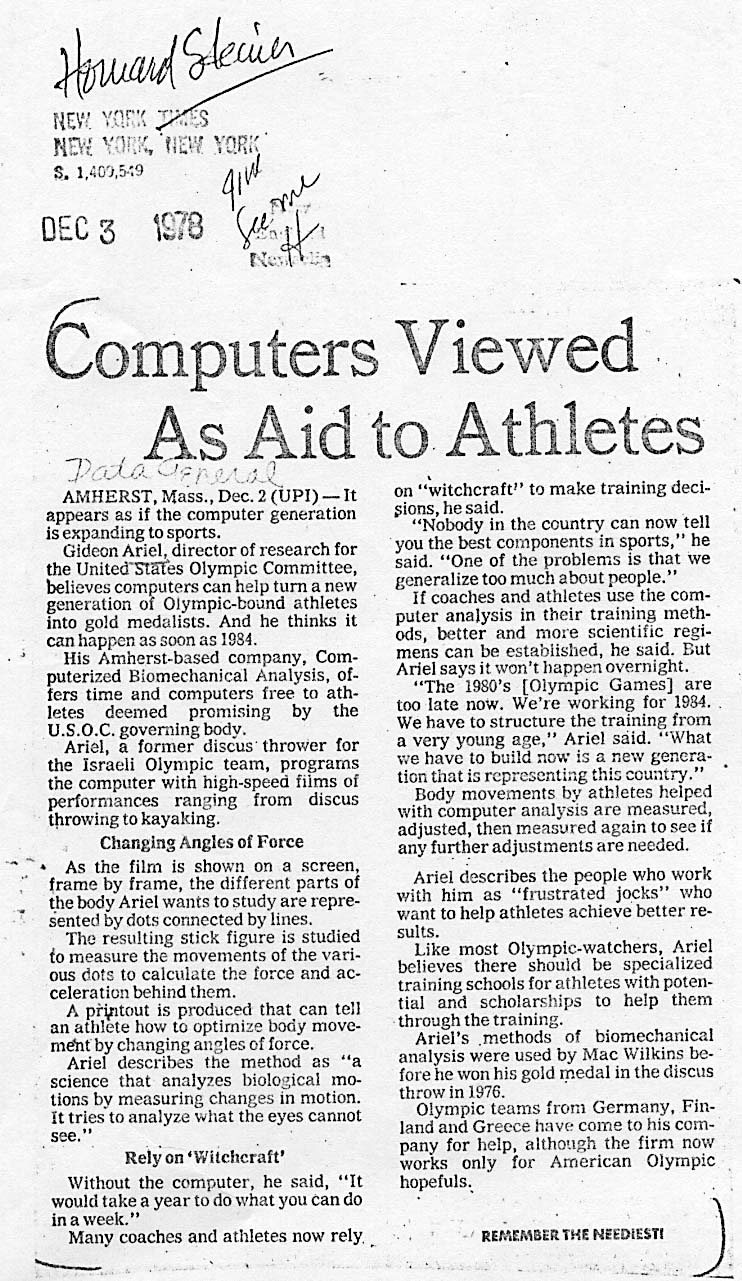Computers Viewed As Aid to Athletes
Gideon Ariel, director of research for the US Olympic Committee, believes computers can help turn a new generation of Olympic-bound athletes into gold medalists
By Unknown in New York Times on Sunday, December 3, 1978
Computers Viewed As Aid to Athletes
Gideon Ariel, director of research for the United States Olympic Committee, believes that computers can aid in training a new generation of Olympic athletes. His company, Computerized Biomechanical Analysis, offers free computer time to promising athletes. The company uses high-speed films of various sports performances, which are then analyzed frame by frame. The movements of the athletes are represented by dots connected by lines, creating a stick figure that can be studied to calculate the force and acceleration of the movements. This data can then be used to optimize body movement by changing angles of force. Ariel believes that this method can help establish better and more scientific training regimens. His methods were used by Mac Wilkins, who won a gold medal in the discus throw in 1976. Olympic teams from Germany, Finland, and Greece have also sought help from his company.
Tip: use the left and right arrow keys
c
DEC 3
computers Viewed As Aid to Athletes
AM HLRST, Mass., Dec. 2 (UPI)-It appears as if the computer generation is expanding to sports.
Gideon Ariel, director of research for the United-StVes Olympic Committee, believes computers can help turn a new generation of Olympic-bound athletes into gold medalists. And he thinks it can happen as soon as 1934.
His Amherst-based company, Coinputerized Biomechanical Analysis, offers time and computers free to athletes deemed promising by the U.S.O.C. governing body.
Ariel, a former discus thrower for the Israeli Olympic team, programs the computer with high-speed films of performances ranging from discus throwing to kayaking.
Changing Angles of Force
As the film is shown on a screen, frame by frame, the different parts of the body Ariel wants to study are represented by dots connected by lines.
The resulting stick figure is studied to measure the movements of the various dots to calculwte the force and acceleration behind them.
A pi itout is produced that can tell an athlete how to optimize body movemdnt by changing an7les of force.
Ariel describes the method as "a science that analyzes biota_ ical motions by measuring changes in motion. It tries to analyze what the eyes cannot see."
Rely on' W itchcraft'
Without the computer, he said, "It would take a year to do what you can do in a week."
Many coaches and athletes now rely.
on "witchcraft" to make training deci$ions, he said.
"Nobody in the country can now tell you the best components in sports," he said. "One of the problems is that we generalize too much about people."
If coaches and athletes use the computer analysis in their training methods, better and more scientific regimens can be established, he said. But Ariel says it won't happen overnight.
"The 19SO's [Olympic Games] are too late now. We'ie working for 1934. We have to structure the training from a very young age," Ariel said. "'What we have to build now is a new generation that is rcpr enti:;g this country."
Body movements athletes helped with computer analysis are measured, adjusted, then measured again to see if any further adjustments are needed.
Ariel describes the people who work with him as "frustrated jocks" who want to help athletes achieve better results.
Like most Olympic-watchers, Ariel believes there should be specialized training schools for athletes with potential and scholarships to help them through the training.
Ariel's methods of biomechanical analysis were used by Mac Wilkins before lie won his gold tredal in the discus throw in 1976.
Olympic teams from Germany, Finland and Greece have come to his company for help, although the firm now works only for American Olympic hopefuls.
REMEMBER THE NEEDIESTI
J_

